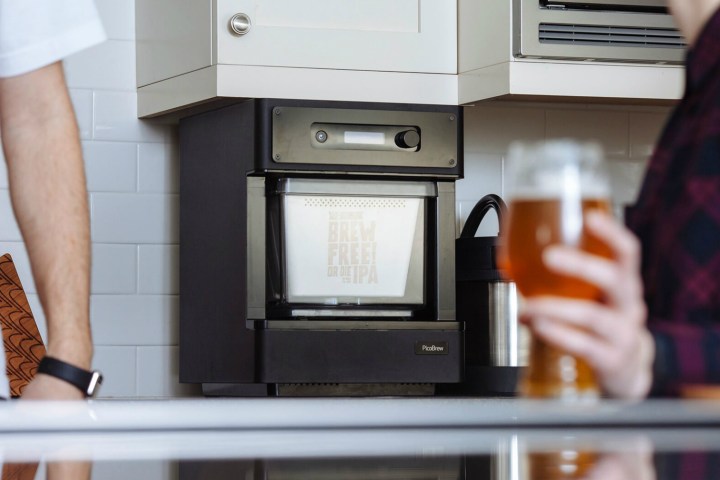
Physically, the device isn’t noticeably smaller than the original Pico, but to help lower the cost, it utilizes a black powder-coated body instead of a stainless steel one, and the OLED display is two lines, so it won’t display the same graphics as the Pico. The bigger differences lie in the keg, which loses the ball-locks that some users found confusing.
“We took the opportunity with the keg to target it a little more toward the new brewer,” Bill Mitchell, PicoBrew’s CEO, told Digital Trends. “It lowers the cost of the product, but it also makes it simpler.” Though it will eventually retail for $549, the Kickstarter campaign drops the price to $279 for very early backers.
The new keg also has a new shape. Though it has the same 1.75-gallon capacity as the old brewing keg, this one is more squat and easier to clean.
“The dip tube is similar to the dip tube you have in a smoothie cup,” said Mitchell. PicoBrew actually looked at smoothie cups for inspiration in order to make something intuitive and dishwasher-safe. The Model C works with the same PicoPacks as the original, and it still makes beer in two hours (this of course doesn’t include the week or so it takes to ferment and carbonate).
The machine recognizes exactly what pack you’ve put in, and it will adjust its settings accordingly. When the machine is helping you out, there’s very little guesswork involved, but there are still some mysteries that go into homebrewing that PicoBrew wants to solve.
Follow the fermentation
One of PicoBrew’s goals is to make novices into beer connoisseurs by teaching them about the whole brewing process. While the original Pico’s directions were mostly easy to follow, the company decided to make an app.
“One of the bits of feedback we got was during the brewing experience, everything was nice and managed, and I can watch it from my browser,” said Mitchell. “Then I’m done brewing and then what?”

Thanks to the original Pico, the company realized newbie brewers were having issues with fermentation. They’d be using the fast fermentation method, and without a good idea of what was going on inside the keg, they’d decide it was done before it really was. They were following the chart provided by PicoBrew, but sometimes the cold temperatures in their kitchen would slow the process. The beer would come out tasting yeasty.
To combat the problem, the new Pico will have a low-power mode that lets it act as a temperature sensor. If brewers keep the keg nearby, the Pico can keep tabs on the ambient temperature and let them keep better tabs on the fermentation process. Mitchell said he hopes one day to have remote temperature sensors and hydrometers for kegs instead.
Beer-of-the-month club
The other new feature PicoBrew is rolling out with the Kickstarter campaign is its Brew Unlimited program. Aimed at those who have this brewing thing down to a science, the program provides two PicoPacks per month for $59. As soon as the machine’s RFID reader picks up that you’ve brewed one of the packs, the company will send another. If you have several kegs, you could brew several beers in a day, to get your money’s worth. PicoBrew expects to have around 200 beers by the end of the month.
Recently, the company introduced its FreeStyle packs, so users can choose which grains and hops they want to make into beer.
“To me, that’s the pinnacle of what we’re trying to get customers to do,” said Mitchell. He wants to convert wine drinkers who discuss terroir and tannins to opt for beer that’s perfectly suited to their meal.
Speaking of pairing with food, the Model C actually has the advantage over the old Pico when it comes to sous vide. There will be a special program on the new version, and you’ll be able to throw your bag of food right into the keg. The machine will circulate the water in and out to keep it a consistent temperature. Maybe one day the BrewPulse app will be able to recommend a great beer to go with that sous vided salmon.


